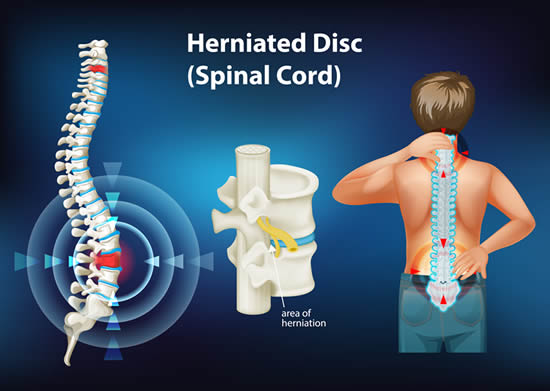The spine is made up of a number of parts that must work together for you to move freely and comfortably. If the discs, or cushiony pads, between the spinal bones are damaged, a herniated disc may be the result. This condition is also known as a slipped disc or ruptured disc. No matter what you call it, the result can sometimes be debilitating.
What is it?
The spinal discs protect against the bones in your spine grinding against one another and causing pain and making you less flexible. Discs consist of a strong outer layer and a soft, jelly-like center. If the outer layer ruptures, the center part may leak into the spinal canal. If that gel or any part of the damaged disc structure touches nerves, it can lead to severe back pain, numbness, or weakness that may extend down the arms or legs.
What causes it?
One of the primary links with disc herniation is aging. Spinal discs naturally deteriorate over time, losing volume. This is called degenerative disc disease. Another contributor to herniated discs is trauma to the body, often from improper lifting of heavy objects or twisting the back. High impact trauma from a fall or car accident can also lead to this condition. Obesity is another tie to disc herniation, and it has also been shown to run in families.
What does it feel like?
Most common in the lower back or neck, disc herniation tends to occur in the most flexible areas of the spine that receive lots of demands during daily activities. There may be no symptoms if the herniation is minor or avoids hitting a nerve, but it can mean severe pain that sometimes radiates down the body. Other symptoms might include numbness, tingling, muscle weakness, balance problems, pain worse when sitting, limping and difficulty moving.
How is it diagnosed?
An appointment with an experienced physician like Dr. Charla Fischer in New York City is the route to identifying a herniated disc. You will be asked questions about your symptoms and perform several movements, such as leg raises, that commonly indicate a possible herniated disc. Image testing like X-Rays, MRI, EMG (electromyogram) or NCS (nerve conduction studies) may be recommended to confirm the diagnosis.
What are the best treatments?
Dr. Fischer will suggest conservative treatments at first to relieve your symptoms. These may include a combination of medications, physical therapy, epidural steroid injections, exercises to strengthen your core muscles, weight loss if that applies, low-impact activities, or quitting smoking if that is a habit.
Sometimes surgery is the best option when other treatments are not successful. Improvements in technology have made spine surgeries less debilitating and scary than they used to be. Many procedures are even performed on an outpatient basis. Some of the most common herniated disc repairs include microdiscectomy, laminectomy, anterior cervical discectomy and fusion, cervical disc replacement, or microlaminoforaminotomy. Dr. Fischer is well-versed in spine surgeries and will explain everything you need to know to get you on the road to recovery from disc herniation.

